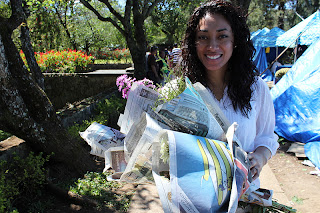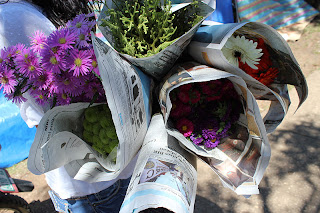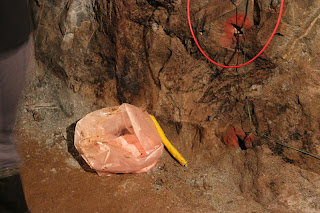The sun returned for our last day in Baguio. I guess the weather just wanted to make our trip to Sagada yesterday more interesting. We started the morning just enjoying the sun and walking around Burnham Park again. We made it back to the market, as promised, and bought bags full of fresh vegetables. Our favorite part though was the flowers again.
Now we knew where they were grown, it was fun to go around and buy them. Hiva spent about $20 and bought a huge arm load of fresh flowers. When she got home and arranged them there were too many for one large vase, she ended up with three different arrangements. Too bad we cannot find a place like that to buy flowers in Manila.
We ate lunch at O Mai Khan, a Mongolian restaurant that was recommended to us. It did not have the romantic ambiance of Choco-Late and Café by the Ruins, but the food was by far more delicious! They have a grill that you take a bowl and add whatever meats and vegetables you want into your dish and then they grill it for you. We could tell that it was a popular place because we arrived just before lunch time and within an hour, the restaurant was packed and cars in the parking lot were not just double, but TRIPLE parked. Definitely a must if you are in Baguio.
We said goodbye to the mansion and the ghost (that we sadly never saw) and we were off!
Our first stop on the way home was Balatoc Mines just outside of Baguio. It is a gold mine (pun not intended). They let you tour some of the older unused portions of the mine to understand what miners go through each day.
They decked us out in water-boots and helmets (which looked GREAT with our shorts we were both wearing) and we went on our guided tour. As we walked past the large area full of stacked bags the guide nonchalantly said, “That is all gold in there just waiting to be processed.” Like it was just every other day, because everyone has stacks of gold ore just hanging around in their backyard!
We were able to see what tools the miners use now, and the ones they used before. Now it seems they do everything "mano mano" by hand. They collect the rocks with their shovels and fill their sacks. So all those stacks of bags were somebody’s hard labor.
At the opening to the tunnel there is a coin box that is used for accountability purposes. Each miner is issued a coin with a specific id number, unique to that miner. Each day a man has to put his coin in the box before he enters the mine and take it out as he leaves. That way if at the end of the day there are still coins in the box the supervisor knows they need to go looking for the missing man. They also showed us the "ice cream cart" which was really the porta-potty for the miners to use"
The tunnel was dark with only two or three lights spanning the whole thing. The guide said those were here for the tourists, the real tunnels have no lights at all. The miners use their flashlights and operate on a buddy system so if one flashlight that goes out, they can share the other.
We used the drill that they prepare holes for dynamite, then they showed us how they wire dynamite into the wall. The guides said that the dynamite alone is not good enough for the miners, they want a larger explosion so they add powder fertilizer to make it bigger. YIKES! She walked us down farther into the tunnel and showed us the small holes that the miners climb into the mine. Talk about claustrophobia. The mine is so hot that most of the men wear as little as possible and sometimes work 8 hours in waist deep water.
The end of the tour they actually blew half a stick of dynamite for us. It was crazy how you could see the boom coming for us from all the way down the tunnel. The whole walls were shaking. Once it hit us it felt like someone had ran into us full body. It knocked me back into the wall and both ears popped. AND that was only one half stick of dynamite—with no fertilizer! These guys must take a toll on their bodies; digging in little holes with small amounts of clothing, breathing in dust and diesel exhaust, and exploding their ear drums. Needless to say I was much more appreciative of the stacks of gold bags outside when we walked past them again.They gave a rock of pyrite (fool's gold) and a certificate of achievement as we left.
The drive home was just as beautiful as the drive up. After making it to Sagada, Kennon road felt like we were driving on a world class highway. We stopped at one point to cross a cable bridge that spanned the valley between two steep mountains. It was the one way people that lived on the other side could go home each day. Not something that I would recommend for someone that has a fear of heights. Again I thought how lucky I was to not be the family that lived there and had to cross that bridge every day (again, pun not intended). Can you imagine crossing it when there was a storm?
You should have seen the weird looks we got from one family as they crossed with us, their faces clearly said, "Why is that white guy crossing our bridge and taking photos." Little do they know, most people don't have cable bridges to their homes.
Here in the Philippines you can tell what the local community does for work and make a living because whatever it is there will be booths all in a row along the roads trying to sell their wares. Most of them all have the same things as the next booth, they are just hoping someone will stop at their booth first. It could be the vegetables, the flowers, clothing, jams, baked goods, furniture, you name it. I guess the trick is knowing which communities sell/make which goods so you know where to shop when you need something.
On the way home we passed one portion of road selling Christmas lights and there was row after row of booths of lights. It was a really festive sight to experience. Finally after 6 hours, Hiva and I were both glad to be home. It was a really fun weekend but there is nothing like being in your own house after a long trip.











































No comments:
Post a Comment